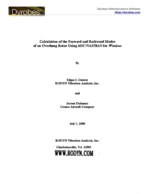Papers
“Calculations of the Forward and Backward Modes of an Overhung Rotor Using MSC-NASTRAN for Windows,” |
Introduction
The purpose of this paper is to review the methods of computing the forward and backward critical speeds and unbalance response of an overhung rotor using MSC/NASTRAN for Windows. The study is motivated by the requirement that it is necessary to accurately calculate the critical speeds of gas turbines, including gyroscopic effects. For example, with certain gas turbine designs, the disk gyroscopic effects can almost double the critical speed, as compared to the planar modes of vibration. In general, all finite element programs are basically designed for structural analysis only. NASTRAN, however, allows the incorporation of skew-symmetric mass, damping, and stiffness matrices into the bulk data set through the use of the DMIG command.
NASTRAN has a number of eigenvalue solvers for computing both real and complex eigenvalues. There are several issues that must be faced when attempting to calculate complex eigenvalues using MSC/NASTRAN for Windows. The Windows interface is FEMAP, which does not support complex eigenvalue analysis or the direct input of DMIG commands for gyroscopic effects. These additional files may be incorporated through the use of INCLUDE statements. The second, and more important, question is which method to use and also how accurate are the various eigenvalue methods. This report is based on an earlier presentation of Rotor-Disk System Gyroscopic Effects in MSC/NASTRAN Dynamic Solutions by H. Bedrossian and N. Veikos of Avco Lycoming Division. In this paper, the classical overhung Dimentberg rotor is analyzed. The same Dimentberg model was also analyzed earlier by Gunter and Fang to compare the predicted forward and backward modes using the finite element rotor dynamics program, DyRoBeS, and the undamped critical speed program, CRITSPD-PC.

